Note: Here’s a spoiler-filled, more detailed version of my review of The Dark Knight Rises. If you want a spoiler-light look at the film, click here.
It’s here. Christopher Nolan has defied the law of superhero trilogies, which seemed so natural that it was akin to gravity. The Dark Knight Rises might not be the perfect piece of cinema, but it does perfectly wrap up Nolan’s Dark Knight trilogy, with enough grace, wit and intelligence to avoid the problems that faced other superhero threequels. While it falls a little short of The Dark Knight, mainly because of what it lacks rather than what it fails at, The Dark Knight Rises manages to make some telling observations about its central character, while proving an epic for our time.
The Dark Knight was the best mainstream film to explore the War on Terror, and The Dark Knight Rises might be the best movie about the social implications of the current economic strife – the philosophy of the “1%.” Finding a way to handle both the political allegory and the central character’s myth in under three hours is no small accomplishment, and Christopher Nolan once again demonstrates why he’s one of the best directors working today. Nobody blends blockbuster scale and aesthetic with sophistication and suspense nearly as well as Nolan.
Nolan has that rare ability to blend pulp entertainment with more high-brow pursuits. This occasionally backfires when fans of either attack him for attempting to have it both ways – fans protesting that he’s “hijacking” the character to insert his own literary ideas, or elitists complaining about the director “lowering himself” to genre fare. I don’t find either criticism especially fair. I think Nolan serves the character of Batman and his world especially well, but that doesn’t mean that Batman is somehow “beneath” social commentary or political analysis.
Nolan has an uncanny ability to be literate and yet accessible, challenging and yet accessible, efficient and yet innovative. In The Dark Knight Rises you can see a whole host of influences. Nolan draws from the comic book fare (Knightfall and No Man’s Land in particular), but also from the current political climate, and even from Charles Dickens’ A Tale of Two Cities. All these influences and ideas are well served by the director, and none jostle against each other. I can’t imagine how difficult it would be to construct a blockbuster around any of these, and yet Nolan proves capable of synthesising all these elements into one hugely satisfying whole.
There’s a lot to digest here. It’s hard to imagine, without spoiling anything, but The Dark Knight Rises is even bigger in scale than The Dark Knight. In The Dark Knight, the Batman fought the Joker for “Gotham’s soul.” Here, the stakes are even greater. “Welcome to the future of Western civilisation,” Bane triumphantly boasts at one point, and Batman finds himself facing a problem on a scale that makes even The Avengers look small in comparison. Bonus points to Nolan for ensuring that Batman can’t defeat the problem by punching it really hard.
The first half of The Dark Knight Rises roars along. It’s telling that a movie approaching three hours in length can still feel a bit rushed in places. I can’t help but feel like the film could have used a tiny bit more room to breath – although wanting more of a film this size is almost certainly a good thing. I have, of course, only seen it once. I will rectify that, but I get a sense that there will be much to digest and discuss in on watching the film again. In particular, I’m already contemplating a massive marathon of the trilogy. I can see the films fitting together rather well.
Much as The Dark Knight effectively picked up the ball from Batman Begins and carried it down the pitch, The Dark Knight Rises feels like a logical continuation and development of the ideas Nolan developed and suggested in The Dark Knight. It’s telling that so much of the film is anchored directly in its predecessor. Nolan apparently once stated that he never held anything back from the other two films – each had to stand on their own and each got everything that he had. He never “saved” anything for the follow-up. If that’s true, it makes the way these three films fit together even more impressive in hindsight.
There are, of course, a few seams in the transition. The movie is centred around the legacy of The Dark Knight. Rachel Dawes and Harvey Dent are both repeatedly referenced, and both play very major roles in the plot – Dawes as a motivator for Bruce Wayne, and Dent for Gotham. Virtually everything that happens here spins out of the Joker’s actions and the attempts to cover them up. As such, the Joker is conspicuous by his absence.
It feels especially significant because every other major villain in the series makes an appearance – even the dead ones. Ra’s Al Ghul and Harvey Two-Face appear via flashback. The Scarecrow gets a juicy cameo. It’s entirely understandable that the joker isn’t present, as it would have been foolish to recast. However, the name is never even mentioned. He feels conspicuous by his absence, even though it’s perfectly rational and logical that Nolan and his crew would not want to touch the character. Even a throw-away line or reference might have been nice.
Which brings us to what the film lacks. It continues the themes and ideas of The Dark Knight perfectly. Nolan is still a phenomenal action director, and the set-pieces are stunning. The ensemble is as pitch perfect as it was back in Batman Begins. However, there isn’t a performance or a character here who serves as a lightning rod to bring all into the same perfect harmony as The Dark Knight. Anne Hathaway is great as Selina Kyle. Tom Hardy is wonderful as Bane. Neither performer (nor their character) is as perfectly overwhelming as Ledger’s Joker. Ledger’s Joker stole the show from a powerhouse ensemble.
Here, the ensemble is every bit as good, with any number of impressive additions, but there just isn’t that same focal point. That isn’t to suggest that any individual element is weak. I think they’re all wonderfully strong and everybody acquits themselves superbly. Marion Cotillard and Joseph Gordon Levitt both work well in supporting roles, and it’s great to see Matthew Modine even in a small role. Selina Kyle is a solid character, and Bane is almost the perfect foil for Batman.
There’s just not that little extra edge to push the movie that tiny bit further, to make it just that little bit better. That sounds like a harsh criticism, but it’s not really. I think that The Dark Knight Rises is as well put together as its direct predecessor, which makes it significantly better than any modern blockbuster. I just suspect that it might not have the same focal point for critical and audience appreciation.
What The Dark Knight Rises has that its predecessors didn’t, and what sets it apart from the bulk of Hollywood franchise fare, making it something truly special… is an ending. Most big movies end with a sequel hook, the promise that patrons can put down more money for another story featuring that character in a few summers. It’s something that comic book characters are especially prone to, do their nature as serial adventurers. They have to keep getting published so they can keep earning, just as movies have to keep getting made to make money.
This lack of an ending prevents closure, and I think it leads franchises to become stale. There’s always the dreaded status quo that must be maintained for marketability. Even master scribe Alan Moore has conceded that this nature of perpetual storytelling, defying these characters of an ending, is one of the things holding back the superhero genre. He wrote in his introduction to Frank Miller’s The Dark Knight Returns:
All of our best and oldest legends recognize that time passes and that people grow old and die. The legend of Robin Hood would not be complete without the final blind arrow shot to determine the site of his grave. The Norse Legends would lose much of their power were it not for the knowledge of an eventual Ragnarek, as would the story of Davy Crockett without the existence of an Alamo. In comic books, however, given the commercial fact that a given character will still have to sell to a given audience in ten years’ time, these elements are missing. The characters remain in the perpetual limbo of their mid-to-late twenties, and the presence of death in their world is at best a temporary and reversible phenomenon.
Nolan has dared to provide an ending here.
I love that Nolan did that, without wussing out. I think that perhaps it’s a more upbeat ending than most iterations of the character might enjoy. (Check out Neil Gaiman’s Whatever Happened to the Caped Crusader? to get a feel for what I mean.) Then again, there are already too many people who would suggest that Nolan’s Batman movies are too bleak, depressing, cynical and fatalistic. I never agreed with that. Indeed, Nolan and Bale’s iteration of Batman was perhaps one of the most optimistic iterations of the character I’ve ever seen. He is contrasted with Ra’s Al Ghul, the Joker, Bane and Talia because he sees the good in people and believes that people are fundamentally decent, rather than animals.
Being honest, I would have preferred a bit of ambiguity about Wayne’s fate. There has to be hope, of course. That is, after all, what Nolan’s Batmanfilms are about – about how hope and idealism can survive the most brutal things imaginable. It also supports the idea that Batman might somehow ascend to the status of legend, that there is reason to believe he might never truly die. I liked the hint about the autopilot with Lucius, although I think Alfred saw far too much of him in France.
A fleeting glimpse would have been enough to let the faithful butler believe in the possibility of a happy ending. And, as much as I believe that Bruce Wayne is fundamentally and inescapably Batman, I like to believe that he could find some measure of happiness. After all, is it wrong for Bruce to enjoy some of the hope he gave Gotham for himself?
(Incidentally, I quite like the theory that Bruce and Selina sold his mother’s pearls – the missing lot from the will – in order to live a comfortable anonymous lifestyle somewhere far away. Ever since Frank Miller incorporated them into the origin, and especially in Batman Begins, the pearls are a handy shorthand for the death of Bruce Wayne’s parents. Letting go of the pearls is letting go of the grief. It’s telling that, at the start of The Dark Knight Rises, Bruce has simply locked them away and compartmentalised them, rather than actually dealing with them. He does the same thing with his grief.)
There’s been a lot of speculation about that final shot, and how Nolan might be giving Warners an “out” to make more Batman movies. I think that interpretting the scene this way is somewhat shallow. After all, there’s no way that Warners produces a movie without Bruce Wayne in the cowl. The “Robin” gag was just a throw-away in-joke, and I’m a bit disappointed they didn’t reveal he was originally Dick Grayson, although perhaps that would have made it inaccessible. Rather, it brings the saga to a fitting a close. Both Batman and Bruce Wayne have survived, and Bruce has truly fashioned something that is much bigger than himself and could have a life outside himself.
Writer Grant Morrison once wrote “Batman and Robin will never die!” and it’s a fascinating idea. A lot of people focus on how crucial Batman’s humanity is to the character. After all, he’s not the lone survivor of a dying planet, a super soldier, a kid who can sling webs. He is just a billionaire. However, Nolan actually connected with the character in the same way Morrison did. Bruce is a man who transcends mere mortality to become something larger than just himself.
When Ra’s Al Ghul confronts him in his cell, Bruce claims to have killed the man. Al Ghul responds, “There are other forms of immortality.” While Bruce recovering from a broken back might seem like the most impossible part of The Dark Knight Rises, this is just theatricality and deception. He does something far more difficult. He ascends to immortality. He becomes an idea. And it’s an idea that can never die. Mending a broken back is nothing compared to crafting your own legend.
(Incidentally, I like how the prison is, in effect, a “Nolanised” version of the Lazarus Pit. In comics, the Pit is a bath that assures Ra’s immortality and can heal all wounds. Here, Bruce is thrown into the Pit with a broken spine and escapes physically and emotionally rejuvenated. You could even argue that Ra’s himself was guaranteed a form of immortality from the Pit. It did, after all, cough up both Bane and Talia, who were dedicated to fulfilling his ambitions. It’s not literally anything like the Lazarus Pit, but it’s a perfect fit thematically.)
The Dark Knight Rises is an ending to the story of the man crafting his own legend. It’s a full stop. That means that Batman’s character arc actually means something. It means that Nolan isn’t just spinning his wheels. It means that there is a bit of weight to the film. There’s more suspense here than I think I’ve seen in any blockbuster for a while. Batman’s fate is up in the air, and so is Gordon’s. So is Alfred’s. It’s an element of risk that is often missing from these films, and it’s to Nolan’s credit that it’s present in almost every frame of The Dark Knight Rises. Watching it for the first time, we don’t know who will live and who will die, which makes the movie all the more effective than it would be otherwise.
While the Joker is conspicuously absent, Ra’s Al Ghul is conspicuously present. This is, of course, fitting. Ra’s is a character who has ascended to a mythic status, much like Wayne must. It also provides a rather firm anchor to Batman Begins. While The Dark Knight was heavily informed by Batman’s relationship to Ra’s, it wasn’t so explicit about it. Saving the Joker is an act that works in the context of the film, but only truly makes sense as a counterpoint to the finalé of Batman Begins.
And so Ra’s pervades the film, despite the rather notable handicap of being dead. His name is dropped repeatedly. Bane is positioned as the heir to Ra’s Al Ghul (“I am the League of Shadows!”), further cementing himself as a counterpart to Batman. Ra’s appears, both as a flashback and as a figment of Bruce’s unconscious. The real villain of the piece is revealed to be Talia, in a twist that would have been ingenious if she wasn’t already a comic book character. The fact that so many had guessed it for so long does undermine it slightly, rendering the twist somewhat obsolete. However, I think the film holds up well outside of that.
In many ways, The Dark Knight Rises feels like a full circle back from Batman Begins. While its themes are more firmly based in The Dark Knight, Nolan inherits his tone from Batman Begins. While many argued that The Dark Knight was a Michael Mann film guest-starring Batman and the Joker, nobody would confuse the genre here. There’s a similarly ominous macguffin threatening Gotham, a bunch of ninjas and even a third act villain reveal.
It’s also worth conceding that The Dark Knight Rises is the most conspicuously fantastical of Nolan’s Batman films. The Dark Knight was firmly grounded, with the Joker taking control of Gotham using nothing but knives and gasoline. While Batman Begins featured a macguffin in the form of a microwave emitter and a healthy dose of fear toxin, it was also relatively anchored in a realistic world. Here, on the other hand, Nolan’s film feels gleefully “comic book”-y.
There’s even an alternate energy source that would make Tony Stark blush, along with suspiciously fast recover times from what should be fatal injuries. The movie’s second and third acts require a major amount of suspension of disbelief from any sort of “realistic” perspective, but Nolan is skilled enough to make it work. The movie doesn’t seem is firmly grounded in the “real” world as The Dark Knight did, with Batman even going globe trotting, but that’s not necessarily a bad thing.
After all, the idea that a terrorist force could secure and hold a major United States city for a matter of months requires a phenomenal amount of suspension of disbelief from the audience. Even though Nolan painstakingly sets it up and executes it with considerable skill, there’s no denying that the second half of the film is every bit as outlandish as The Avengers. However, I would argue that it feels more substantial because the threat remains couched in the philosophy that Nolan developed in the previous two films, and serves as a vehicle for Nolan to really push his themes to the fore.
I actually quite liked it – I like the idea of the world of Batman developing into a more fantastic place, even if it’s still firmly rooted in the real world. Perhaps the crisis that grips Gotham seems a little bit too outlandish, but it’s still thematically grounded in the Joker’s crime spree from The Dark Knight. One imagines that he’d look at what Bane did to Gotham, and he’d laugh with manic glee. In fact, I think the movie works so very well because despite the fantastic nature of what is occurring, it’s all grounded in the same basic moral philosophy of The Dark Knight and Batman Begins, just on a larger scale.
Ironically, given his appearance and his tone, Nolan’s Batman has always been about hope. Naturally, the forces that rise up against him have always been opposed to that. Ra’s Al Ghul, the Joker and now Bane all believe in the worst of people. All three believed that man is basically savage. If you remove the constraints of civilisation and society from a people, they become animalistic. Bane’s “social experiment” is just much vaster than the Joker’s.
Nolan returns to the image of ice a few times in the film. The opening bat logo is in the form of cracking ice. (In Batman Begins, it was a flock of bats. In The Dark Knight, it was an explosion.) In his delightful cameo, Doctor Crane punishes the “guilty” of Gotham by exiling them across a field of ice. Inevitably, it creaks and eventually cracks beneath them, sending the poor convict to a freezing grave.
The implications are obvious. The characters are literally on thin ice, if you’ll pardon a visual pun. Everything Batman and Gordon have built is so delicate that it could easily crack like the ice beneath them. The status that Gotham’s wealthy citizens have built up is just as fragile. Dealing with an increasingly frustrated and enraged population, they must walk delicately. It’s a metaphor that is just as appropriate to The Dark Knight– any attempt to defeat the Joker had to be cautious, lest the moral high ground collapse from underneath them.
Naturally, in both The Dark Knight Rises and The Dark Knight, Batman exists as a character who can move across that very fragile surface. He is, as an idea or a symbol or a concept, simultaneously larger and yet lighter than any real person. In The Dark Knight, he could absorb the moral consequences of the actions needed to defeat the Joker. Here, the metaphor is a lot more literal, as Batman returns to Gotham by crossing the river of ice – a feat we’ve been told (and shown) is impossible.
Bane claims that he and the League of Shadows have arrived in Gotham as “liberators; to return control of Gotham to the people.” Cut off from the outside world, with infrastructure disabled and the police force removed from the equation, Bane has literally removed the shackles of civilisation from the people of Gotham. “Do as you please,” Bane advises the citizens, hoping to turn them loose, that they’ll become nothing more than a pack of rabid dogs.
The political implications are obvious. Batman has always dealt with elements of class. He’s a rich person who puts on a fancy dress costume to beat up criminals. Bob Kane’s original Batman stories frequently featured rich people in mansions, with poor people relegated to playing thugs or goons. It’s been tackled and played with over the years (most notably by Alan Grant), but it’s also been a strong thematic element in Nolan’s take on the character.
Nolan’s Batman rather pointedly spent years in poverty and anonymity to understand economic suffering so as to temper his attitudes to crime. In The Dark Knight, the Joker doesn’t need money to cause anarchy, operating on a shoestring budget in contrast to Batman’s millions. Even the fantastic “prisoners dilemma” in the final act of The Dark Knightsaw the wealthy and powerful of Gotham (those ferry tickets must have cost a fortune) pitted against the poor prisoners.
So it’s no surprise that class plays a pretty major role in The Dark Knight Rises. We’re informed early on that gangland crime has been pretty much wiped out by the draconian “Dent Act”, enacted after the death of Harvey Dent. However, it seems that white collar crime has only festered without any serious attempt to fight it. A wealthy citizen of Gotham, John Daggett, seeks to treat Bane as nothing more than a hired gun, assuming that his money gives him leverage over the terrorist.
He treats Bane as an idiot, a pawn in his scheme to take control of Wayne Enterprises. Bane, rather brutally, dismisses the idea that Daggett’s money buys influence over him. When Daggett points out that he will pay Bane, the villain mocking asks, “This gives you power over me?” Later on, while robbing the stock exchange, Bane is patronisingly informed, “There’s no money here to steal!” He responds by challenging the stock broker, “Then why are you here?” When Selina is hired by Daggett to do a job, it’s very clear that she’s hired because her social status makes her expendable. “No one’s going to miss you.” Later on, after a hard day watching his hired goons do all the work, Daggett is in the mood for some objectification. “Can we get some girls up here?” he asks, as if ordering a nice bottle of Dom.
It’s been argued that The Dark Knight Rises is a conservative film built on the fear of the disenfranchised. However, while Nolan’s film has understandabled concerns about the destruction of social institutions in anger (no matter how justified and righteous), the movie also concedes that those systems can be abused and manipulated. Daggett is almost as reprehensible as Bane, lacking even the villain’s ideology. Alfred and Blake both chew Bruce out on neglecting his social responsibility. Blake holds him to account for failing to properly keep an eye on the world outside and to meet his obligations, while Alfred blames him for hoarding his tools and refusing to share with wider society.
In fact, when Bruce calls Selina out, she dismisses him – arguing that he has no idea what he’s talking about. “You don’t get to judge,” she warns him. And she’s entirely justified in doing so. If the Joker’s imagery was associated with dogs (“I’m a dog chasing cars” and “we’ll see just how loyal a hungry dog is”), then Bane is associated with the underclass. Literally. He lives in the sewers with an entire underclass of people. He lived underground his entire life. His plans to destroy Gotham are literally mixed into the foundations of the buildings are town. His agents are janitors and shoe-shiners, people that the wealthy wouldn’t look at twice. Batman was born to wealth and class. Selina and Bane were born to neither.
So it’s telling that the first attacks in Bane’s “new Gotham” are very clearly directed towards the wealthy, dragged from their beds and brought before kangaroo courts convened by lunatics. It’s the redistribution of wealth, with the laws that protected the “1%” no longer enforced. Far from an idealised utopia, it creates a savage world where force is the only currency that matters. “This used to be somebody’s home,” Selina remarks mournfully. Her friend responds, “Now this is everybody’s home.” Vive la revolution!
It gives the movie a decidedly political edge, to complement the commentary in The Dark Knight about the War on Terror. In fact, Nolan does a rather excellent job exploring that theme here as well. It seems like Nolan might have been a little too concerned about a neo-conservative reading of The Dark Knight, where Batman was seen as a stand-in for President Bush, impugning liberty for the greater good – conducting wire-taps and extraordinary rendition, while lying to his people for their own good.
Nolan’s Batman trilogy has always been about consequences, and that’s very much the case here. Nolan turns that political reading on its head and reverses it dramatically. Batman ran his own extraordinary rendition from Hong Kong in The Dark Knight. Here, Batman is a victim of the tactic, dragged off to an anonymous hell-hole on the other side of the world to torture. (“Not of your body,” Bane clarifies. “Of your soul.”)
By his very nature, Batman assumes moral authority in Gotham without any mandate to do so. Bane does the same here – he brands his band of goons “liberators” of the great city – a rather uncomfortable inversion of the portrayal of the Joker in The Dark Knight as a “terrorist.” While Batman adopted the tools of American foreign policy to make Gotham a better place, Bane uses those same tools to attack it. He seizes control of Gotham (it’s explicitly described as an “occupation”) and turns it into a “failed state.” If Bane’s lower-class rebellion is a radically right-wing nightmarish version of the Occupy Movement, his takeover of Gotham is a radically left-wing reimagining of the United State’s involvement in Iraq and Afghanistan.
In many ways, Nolan is exploring the moral implications of these actions by turning them on their head. Some might call Batman’s fate here poetic justice, the humbling of a man who thought himself above the rule of law. And Nolan doesn’t just punish Bruce for his larger actions – he also brings the characters’ personal demons home to roost. In The Dark Knight, Alfred lied to Bruce about Rachel in order to give him the strength to endure.
Here, Alfred finds that the lie has only caused more harm than good, despite his best efforts. When Alfred finally works up the courage to tell Bruce the truth about Harvey and Rachel, Bruce has become so commited to the lie that he physically can’t hear the truth. “How dare you try to use Rachel against me!?” he accuses Alfred. At one point, Alfred begs Bruce to let the truth come out, instead of continuing to try “to outsmart it.”
The Dark Knight Rises is about consequences. And not just from The Dark Knight, although it’s a major part of it. Harvey Dent’s heroic legacy is a lie, but a lie that held the city together. What happens when you remove that? We’re told early on that Commissioner Gordon has been falling apart. His wife moved to Cleveland with the kids. He seems to want to tell the truth, and is crushed by the lie. Bane uses that, rather pointedly. That’s the problem with a lie – it turns the truth into a weapon.
There, once again, The Dark Knight Rises quite likes the idea of something good being corrupted into something terrible. There’s a refreshing moral sophistication to Nolan’s series, one that defies attempts to read a particular political ideology into. The series repeatedly suggests that ideas and concepts are not necessarily inherently moral or immoral – it’s about the people who use those tools and devices. Bane is an evil Batman, and Talia is an evil Bruce – both shaped by similar circumstances but with very different results.
However, and I really like this, it’s interesting to see Batman held to account for something even earlier than that. At the end of Batman Begins, Bruce left Ra’s Al Ghul to die. Here, is explicitly and bluntly called out on it. “You murdered him,” Talia accuses Bruce at the climax of this film, and Bruce doesn’t deny it either.
It’s implied that his decision to kill Ra’s is in some small way related to everything that happens in The Dark Knight Rises. It’s suggested that Bane and Talia were only capable of gaining control of the League of Shadows following Ra’s death, and that their attack on Gotham is motivated by the fact that Bruce murdered Ra’s there. It’s a nice touch, because it thematically ties into the idea that Bruce is evolving, learning and making mistakes. His decision to let Ra’s die was a mistake. That was implied by his decision to save the Joker at the climax of The Dark Knight and made explicit by the consequences seen here.
That’s an aspect I like about Nolan’s trilogy – each instalment shapes and informs the others both proactively and retrospectively. Sometimes this overtly casts earlier decisions in a different light – like Bruce’s refusal to save Ra’s at the end of Batman Begins, which he tempers in The Dark Knight and comes back to haunt him in The Dark Knight Rises. Sometimes it suggests character evolution – Batman quoting Ra’s doctrine (“the criminal is not complicated”) in relation to the Joker during The Dark Knight. Sometimrs it’s just really well-placed foreshadowing – like the comment that his new armour in The Dark Knight will increase mobility leave him vulnerable to knives, which comes into play at the climax of The Dark Knight Rises. They can be viewed independently, but work best as a whole.
In fact, I like that Ra’s death plays such a key role here. As discussed above, The Dark Knight Rises deals with the idea that something good can easily be perverted. A lie for the greater good can be come a weapon. A source of unlimited power can become a gigantic bomb. Lucius Fox takes great care of Bruce’s toys “to keep them from falling into the wrong hands”, but they end up “gratefully accepted” by the League of Shadows. Even hope is turned into a weapon by Bane. That’s the worst part of the prison where he was held – the constant hope of escape, even though it was practically impossible.
So it’s fitting that Bruce finds himself opposed by the Bane and Talia, the spiritual successors and heirs apparent to the man he killed. Bane mirrors Batman as Talia mirrors Bruce, albeit perverted and inverted. Talia gets relatively little screentime as herself, rather than posing as Miranda Tate, but she’s still a crucial figure and a fitting thematic foil to Bruce. Bruce was shaped into what he’d become by the murder of his parents, just as Talia was shaped the loss of both her parents.
While Bruce witnessed his parents die in an alley, Talie was cast into a pit without her father, and witnessed her mother die at an early age. The public persona of Miranda Tate is no different than the public persona of Bruce Wayne, the airhead billionaire trustfund eccentric. Both carry scars of their dual lives. It’s telling that Miranda’s back is scarred, mirroring that fantastic shot from The Dark Knight where we see the price of being Batman. (It’s also interesting that the climax involves a “misdirection” by Talia when she identifies the wrong truck to Gordon – a strategy Bruce would be proud of.)
I think Talia is fairly essential to Bruce’s character arc, if only because she illustrates just how dark a path obsession can lead. Her entire life was a lie so that she could get close enough to Bruce to put her plan into motion – “the knife that waits years without forgetting.” Dying she boasts, “My father’s work is done.” I think the most wonderful part of the “reveal” was a smaller revelation tucked away inside that moment of realisation between Bruce and Talia.
I know most people had been speculating that Miranda was really Talia from the moment Cotillard was cast, so that wasn’t as big a surprise as it would have been. (That said, Nolan actually sets up the reveal remarkably well, on re-watching the film everything from remarks about “restoring balance” to he implicit knowledge of Batman as Bruce’s “save the world” project through to her dialogue about fire.) However, I like the revelation that Bane and Talia were not “excommunicated” from the League just because of their extremist views. They were ejected from the League by Ra’s because he didn’t like what his daughter was becoming. It wasn’t the act of a father rejecting his daughter and her protector, but of a father trying to protect his family.
That gives Talia’s death – from what looks like a broken vertebrae, mirroring Bruce’s injury earlier – a sense of tragic irony. She dies avenging her father, but that is never what he would have wanted. What would Bruce’s parents have wanted? Would they have wanted him to life a life of constant rage and agony, and to die alone and unfulfilled? It’s a scene that really sells the idea that Bruce could, once and for all, leave Gotham and Batman behind completely. One senses that this gave Bruce a rather literal idea of the inevitable ending of his career as Batman – dying in service of an idea his parents probably never wanted.
(In the movie implies that Bruce hadn’t made up his mind to give up on returning to Gotham. After saving Blake, he tells the cop, “Don’t thank me yet.” The addition of the “yet” would seem to suggest Bruce intended on staying around, or was at least seriously considering it. I like the idea that the sight of Talia dying from a spinal injury – like the one that crippled him – and in the service of something she only thought her father would want had a profound effect on Bruce. I also think he only decided to fake his death after that point. Rather than, for example, setting the plane on auto-pilot (which, we find out, he’d fixed earlier) and hanging around.)
It’s also interesting how Nolan here actually explores Ra’s Al Ghul’s backstory. Very few threequels would devote so much time to a character who died two films earlier, let alone to adding nuance and depth to his portrayal. All of a sudden, the Ra’s Al Ghul of Batman Begins is humanised. He was introduced as a surrogate father figure to Bruce, only to warp into a mass murdering psychopath consumed by his grief. While Liam Neeson was fantastic, Ra’s was a reasonably generic (if well developed) bad guy.
The Dark Knight Rises brings that a full circle by making Ra’s a more tragic figure. A large part of this sequence of films has been Bruce learning to reject the idea espoused by Ra’s that “the criminal is not complicated.” Here, Ra’s becomes a lot more tragic and complex. We only saw Bruce looking to make things fit together with a surrogate father figure. Now we see Ra’s trying to find a foster a relationship with a surrogate child. There’s a notion that the scenery-chewing fiend from the first film perhaps recognised a cycle of violence that threatened to consume his daughter, even if he couldn’t break free of it himself.
More than that, though, Talia effective completes the sense of inversion by turning Bruce into a variation of Joe Chill. He murdered her father. Sure, he had a reason to do so, to save the city. Joe Chill killed Bruce and Martha in order to eat. As Chill concedes, “That don’t change what I did.” Bruce killed a father, which in turn led the man’s child to fashion herself into a weapon to strike back at Bruce. It’s no coincidence that her back story is so similar to Bruce’s.
That’s the key here, and I think one of the themes of Nolan’s trilogy. These things are all tools. These elements aren’t inherently good or bad – it’s how they are used and people who use them. Even Bruce’s life could have been perverted to produce a sinister supervillain. Even Batman himself is a tool that can be used for good or for ill. All that matters is what people do with that. Bruce is a decent person, who puts his past, his wealth and Batman to good use. In the end, it comes down to people themselves to use these tools, rather than relying on them. As Gordon watches Gotham burn, he can see that it’s up to the city to save itself. “This only gets fixed from inside the city.”
Bruce explains at one point why he worn a mask. It was to protect the ones he loved, but also to send a message. “Batman can be anybody,” he confesses. “That was the point.” Batman is, after all, bigger than Bruce. He’s an idea. He can, as Alfred argued, endure. Batman’s actually on screen from remarkably little of the film, but his symbol is ubiquitous. While the cape and cowl might be absent, his presence is definitely felt. Primitive “Bat” signals are etched in chalk around Gotham, like memorials to a fallen soldier – a symbol of the resistance. At one point, Bane is confronted with a gigantic flaming Bat Signal as Bruce announces his return to Gotham.
“Impossible!” Bane declares, as he realises that a little physical violence might break a man, but can’t destroy a legend or a myth. “I broke you!” he gasps in agony, revealing that Bane never really understood how completely Batman transcended Bruce. Batman is bigger than just Bruce. He’s a concept, an idea. He’s more than the flesh and blood and fancy gadgets. I think that’s one of the things I like about Nolan’s films – just how clearly they focus on Batman as an idea that is, to quote Ra’s Al Ghul, “more than just a man.” In a way, The Dark Knight Rises sees Ra’s quote to Bruce rung true – it sees his observation in Batman Begins play itself out.
And that, of course, is where Bane comes into it. I think that Nolan has crafted pretty much the perfect version of Bane, an iteration of the character who is perhaps the best that the villain could ever be. Bane isn’t just a goon in a silly mask, as he was in Batman & Robin or even in Batman: The Animated Series. Instead, he’s developed as a character who exists in dynamic opposition to Bruce. Nolan takes the best aspects of the character and improves upon them.
He’s defined as the very opposite of Batman, right down to him mask. Batman’s mask covers all of his face except his mouth. Bane’s mask pretty much only covers his mouth. Bane even operates using technology appropriated from Batman. The sewers are pretty much Bane’s Batcave, and the character’s modus operandi is constructed to compliment Batman. He’s a planner, much like Bruce.
It’s telling that Bane is introduced in a powerhouse action sequence that actually mirrors the closing sequence from Batman Begins. In both situations, the character finds themselves hopelessly outclassed aboard a method of transportation hurdling towards defeat. In both cases, the character’s opponent appearsto have the upper hand. The revelation (or the twist) reveals that the character is actually planning to destroy the method of transport, rather than merely hijacking it.
Consider this exchange between Ra’s Al Ghul and Bruce in Batman Begins:
Don’t be afraid, Bruce. You’re just an ordinary man in a cape. That’s why you can’t fight injustice, and that’s why you can’t stop this train.
Who said anything about stopping it?
Compare it to this one between a smarmy CIA handler and Bane:
Congratulations, you got yourself caught. Now what’s the next step of your masterplan?
Crashing this plane.
However, Nolan takes it much further than that. We’re told that Bane grew up in a prison, like his comic book counterpart. However, the best part of this is the design. Bane’s prison is designed to evoke the well from Batman Begins – the hole through which Bruce found the bats that would inspire him. Discussing the origins of Bane, Alfred comments, “Sometimes a man rises from the darkness. Sometimes the pit sends something back.” In many ways, the cave underneath Wayne Manor served a similar purpose, sending back the idea for Batman, implanted deep in Wayne’s subconscious.
Bane even seems to adopt a technique and methodology similar to Batman. After pulling off a daring aerial escape, he assures his captive. “Now is not the time for fear. That comes later.” Bane’s reputation and his ability to generate fear are an important part of what makes him so significant a threat. Much like China’s extradition laws could not protect Lau from Batman in The Dark Knight, Selina knows that the G.C.P.D. cannot protect her from Bane. (“You should be as afraid of him as I am,” she advises Blake.)
Bane even makes the same sort of grandiose theatrical gestures that Batman used – albeit for the opposite purpose. In Batman Begins, Bruce created a bat-signal by tying a mobster to a searchlight for the world to see. It was a clear threat to the criminals and the corrupt, a declaration of intent. Bane deals with a covert military intrusion into Gotham using the same sort of theatricality. “Hang them. Where the world will see.” It’s a very clear statement directed towards the forces of law and order.
Much like Bruce, Bane has ascended to the status of legend. Bruce is told the story of how one prisoner managed to escape the hellish pit of a prison, but the storyteller dismisses it as “an old myth, nothing more.” Bane perfectly mirrors the Batman half of Bruce Wayne, with his mask literally serving to numb the massive pain that he feels. We’re told that Bane is in “constant agony” underneath it. His pain might be more literal than Bruce’s existential rage, but for both characters “the mask holds the pain at bay.” It’s somewhat fitting, then, that Batman defeats Bane by attempting to destroy the mask rather than the man. (Ironically, before Bruce destroys his own mask.)
In fact, it’s fascinating that Batman effectively defeats Bane and Talia by mirroring their attacks on him. Bane breaks Batman’s back; Talia ends up with a snapped neck. Bane destroys Bruce’s mask by pounding it until it cracks, while Bruce smashes Bane’s mask. Those actions can’t destroy Bruce because his two identities are so strongly intertwined. When Bruce is broken, Batman can rise. When Batman’s cowl breaks, Bruce is underneath it. Despite how closely Bane and Talia are integrated, they haven’t a union as effective as Bruce and Batman. There’s nothing underneath Bane’s mask to help him survive its destruction. Talia has nothing to help her survive her broken back.
It’s possible to argue that Bane is counterpart to Batman, but without the Bruce Wayne persona. At the start of the film, the Mayor of Gotham refers to Batman as “a murderous thug in a mask”, and that’s pretty much what Bane is. Bane doesn’t have a life outside the mask, and is incapable of taking it off without being in severe pain. The person behind the mask is never named, and is of little importance. Even Bane himself concedes, “Nobody cared who I was until I put on the mask.”
Given how so much of The Dark Knight Rises explores what Bruce Wayne is without Batman, it’s a very effective mirror for the character and I think that Bane is the perfect counterpoint to Batman in this film. Bane is pretty much Batman thrown back against Batman, but without any of the humanity and compassion. Bruce sincerely hopes that he can use Batman might make the world a better place, but Bane lacks that sense of hope. Bane is just nihilistic anger without any optimism behind him.
While the Joker firmly rejected Batman’s optimistic world view, Bane actually acknowledges it, to a point. The Joker could never understand Bruce’s faith in humanity, while Bane understands it perfectly. He just doesn’t think it can ever be realised – hope is a weakness. To Bane, hope is just that bright light you can never actually reach, teasing and tempting you. To Bane, hope is only useful as a tool to understand despair. Without hope, despair cannot truly exist.
I really liked Tom Hardy as Bane. While the character doesn’t get to steal the show in the same way the Joker did, Hardy has a great deal of fun. He seems to be consciously and anxiously flexing his muscles, as if waiting for something to happen – for the mayhem to start. “Let the games begin!” he warns Gotham, gleefully. There are wonderfully weird moments of humanity glimpsed beneath the character’s cold demeanour. As he listens to the national anthem before a terrorist attack, he sincerely notes, “That’s a lovely, lovely voice.” When he takes control of the Gotham Stock Exchange, he even gives a curt nod to one of the hostages.
Bane fits in quite well, much better than I honestly thought the character would. While the Joker proved a philosophical and intellectual challenge to Batman, Bane is instead a character how can’t be defeated by Batman’s physicality. In their first confrontation, Batman hammers Bane with everything he has, and Bane barely flinches. Even Batman’s usual tricks are completely useless. “Theatricality and deception,” Bane notes. “Powerful agents to the uninitiated.” Basically, Bane is a character who exists to counter Batman’s strength and tactics. He’s a more hardcore version of the hero. “You merely adopted the dark. I was born to it.”
And Nolan actually uses the character to the best degree possible. Bane was famously invented for one purpose and one purpose only: to break Batman. Both mentally and physically. Here, Nolan even manages to extend that a little bit further as Bane not only breaks Batman, but makes sure that Bruce is both broke and broken by his systemic attacks. I really think that Nolan has managed to craft the best version of this relatively recent creation, and I think that the character actually fits Nolan’s story perfectly. It’s interesting that Nolan has always found the right characters to use, no matter when they were created or which era they belonged to.
One touch I quite liked is how Christopher Nolan paired a Batman counterpart (Bane) with a Bruce Wayne counterpart (Talia) to create a two-headed foe for Batman. That was one part of the underrated Batman Returns that I really liked, with Max Shreck and the Penguin both forming a direct counterpart to Bruce and Batman. Nolan here seems to underscore that Bruce and Batman exist in a co-dependent relationship that can’t even be effectively mirrored between two different people.
Bane and Talia are as close as two people can be. They actually seem weirdly affectionate, and sort of sweet in a creepy way. However, even then they still lack the support that Bruce Wayne gives to Batman and vice versa. Bruce Wayne needed Batman, just as Batman needed Bruce – but the two needed to be integrated more closely than even Bane and Talia could be. It’s a very nice use of structural mirroring, and I’ll confess that it’s a little disappointing that Talia is more structurally important than she is developed as a character in her own right.
That said, Bane and Talia are really just devices here, just as Ra’s Al Ghul was in Batman Begins. They both exist to challenge Bruce, who is a far more important character in this trilogy than he has been in any other live action adaptation. The Joker, of course, did the same in The Dark Knight, but he stole the show in a way that Bane, Talia and Ra’s don’t quite. Much like in Batman Begins, Bruce is very much the central character here, and Nolan makes it clear that while the character has the best intentions and the right idea, he’s not necessarily the healthiest of specimens.
We’re introduced to a version of Bruce Wayne who has retired from being Batman. In many ways, that retirement is quite like the one in Frank Miller’s The Dark Knight Returns, which was a heavily influence here. (Appropriately, Miller’s Year One can be seen as an influence on Batman Begins. It creates a nice bookend effect.) Nolan finds a way to work in several wonderful references to the iconic Batman story, from Bruce’s decision to use an exo-skeleton to help him maintain his youthful vigour, through to interactions between a rookie cop and veteran.
In one of the movies more impressive and engaging moments early on, the lights go dim during a tunnel chase. The younger cop has no idea what is going on. His partner does. “Boy, you’re in for a show tonight, son.” (I also liked the scene where the rookie tries to apprehend Batman with his gun. “Put that away before you hurt yourself,” his experienced partner advises, as Batman shoots a look that could kill.) It’s clear that Nolan has a lot of fondness for his source material, even when he (smartly) refuses to be bound to it literally.
Nolan’s The Dark Knight Rises picks up in a world no too unfamiliar to fans of Miller’s The Dark Knight Returns. Bruce has become a shut-in. He hosts fancy fund raisers on his property, but never turns up at them. He’s still hiding in the shadows, a figure barely there – only this time he’s not doing it in costume. His hair has gone grey. Nothing seems to engage or interest him. (Indeed, much like Miller’s Bruce Wayne, he celebrates his victory over the Batman persona by growing facial hair – making it pointless to wear the cowl.) He has a “practised apathy.”
Ironically, this seems to evoke rumours that Christopher Nolan was going to make a Howard Hughes bio-pic, as Wayne becomes exactly that sort of eccentric shut-in, with characters joking about him “peeing into Mason jars.” There’s a sense that Bruce wants to minimise human contact. When a member of the help makes off with a priceless heirloom (which is a nice nod to the Batman mythos, and ties back to Bruce’s origin), Bruce warns Alfred, “Maybe you should stop letting them in this wing of the house.”
There’s a sense that Bruce is still Batman, even if he hung up his cape and cowl a long time ago. Even though it’s implied he hasn’t dressed up as Batman since the events of The Dark Knight, he still builds and maintains a Batcave on the grounds of Wayne Manor. He still practices archery. He refuses to get back in the world, despite Alfred’s urging, lamenting, “There’s nothing out there for me.”
It’s revealed early on that not only has Batman been retired, but – to an extent – Bruce Wayne has been as well. We’re told that Wayne’s personal finances are in trouble. However, the trouble isn’t recent. Bruce has been so disengaged that he hasn’t noticed his empire slowly collapsing over the course of two years. Even Alfred holds out little hope for Bruce. Early in the adventure, the faithful butler accuses his young ward, “You only see one end to your journey.”
Caine is fantastic as Alfred, and The Dark Knight Rises picks up his character arc where Batman Begins left off. There’s a sense that he’s a character who really tried to take care of Bruce after his parents dies, but proved singularly unable to. In one gut-wretching scene, Alfred begs his old friends to forgive him for what he sees as his failure to guide Bruce to a healthier adulthood. “I’m so sorry, I failed you. You trusted me, and I failed you.” It’s Alfred who really serves as the emotional catalyst for The Dark Knight Rises, articulating the inevitable and inescapable conclusion of Bruce’s dangerous journey.
I actually quite like that Alfred here has had enough that he simply can’t do it any longer. Batman Beginscalled the character out as an enabler, and suggested that Bruce Wayne’s mission had been rooted in Alfred’s stern attempt to convince Bruce that the criminal was solely responsible for the deaths of Thomas and Martha Wayne. Alfred’s a very interesting character, once you get past his use as a convenient plot device. He’s a man who is given charge of his old friend’s son, and then has to watch as that son slowly throws his life away.
Alfred is as close to a father as Bruce has had over the course of this trilogy, and his emotional response to Bruce’s actions seem completely organic and natural. Even if you believed that Batman was a lofty ideal, and one worth serving, would you be able to watch a boy you raised continue to put himself in constant danger like that? Michael Caine is amazing, but the part is perhaps the best written and most developed iteration of Alfred I have ever seen. Caine nails the emotional moments, and it’s very clear to see that he has a point. What Bruce is living can’t count as a life.
In fact, Nolan’s Batman films have always adopted a refreshingly amoral approach to the Caped Crusader. While explaining why Bruce would do what he does, Nolan has dared to ask whether or not it’s objectively the right thing – something superhero movies take for granted. Here, he suggests that Batman is an act of hubris on the part of Bruce, an example of the character’s arrogance. It’s telling that Bruce dismisses Bane as a threat as quickly as he dismissed the Joker. “Bane’s just a mercenary,”Bruce tells Alfred, recalling comments about how criminals aren’t complicated. And we all know how that ended up last time. Maybe he should just worry about crooks who refer to themselves using nouns like “Bane” and “Joker.”
At another point, Bruce engages in an epic chase with Bane. The hot-shot would-be police commissioner decides to make his name by capturing Batman. The resulting chaos ensures that Bane manages to escape. When Alfred confronts Bruce about it, the millionaire responds, “The police weren’t getting it done.” Alfred counters with the idea that Batman might be causing more harm and confusion than he prevents. “Maybe they would have if you didn’t lead them on a merry chase.”
It’s interesting that The Dark Knight Rises sees Batman a lot more comfortable in his sexuality. Even his relationship with Rachel in Batman Begins and The Dark Knight was weirdly asexual (and unconsummated), an idealise romantic urge rather than any sort of sexual chemistry. The women that Bruce hung around with in those films were explicitly “beards” designed to draw attention away from his other nocturnal activities. I always thought that this was a nice way of symbolising Bruce’s emotional immaturity, suggesting that he never really grew up. Even some of his flirting with Selina seems like high school dialogue, as he inquires on behalf of his “powerful friend.”
And yet, despite that, this is perhaps the most sexual of Nolan’s films – perhaps suggesting that Bruce’s personality is maturing. Instead of devoting himself to the one girl he cannot get, Bruce finds himself actively courting and flirting with two girls. There’s the idealised Miranda Tate, and the kinky Selina Kyle. Both relationships are far more physical than anything between Bruce and Rachel. It’s a nice touch, and another way of suggesting that Bruce might be coming out of his shell, so to speak.
However, it’s interesting that Batman is the far more aggressively sexual of the two personalities. When Selina Kyle catches Bruce’s eye, he doesn’t pursue her as Bruce Wayne or call the cops. He pulls the Batman out of mothball. He gets himself dressed up in his fancy suit of armour and goes on the prowl. Bruce Wayne is flirty with Selina, but cautious. Batman, on the other hand, is a lot more aggressive and dynamic. The pair relate to each other far more easily as Catwoman and Batman than Selina and Bruce.
When Selina apologises about Bruce Wayne’s sad state of financial affairs, Bruce timidly calls her out on it and says that she isn’t. When the pair meet as Batman and Catwoman, he forcibly disarms her (“no guns! no killing!”) before taking her for a spin in his fancy joyride. There’s a note of showing off as he brags, “This isn’t a car.” While Bruce Wayne can’t let her have his mother’s pearls (think of the Fruedian implications!), Batman is more than happy to give her a fancy set of wheels.
That said, the ending does seem a little strange. Bale and Hathaway have chemistry, but Selina did sell out Bruce to Bane, before Bane broke his back. I wonder how long before that gets used in couple’s therapy. It feels strange to see the two of them run off together. I’d almost have been happy to leave it with the passionate kiss and have Bruce at that French café alone. It just seems a little bit weird, but then I think that short clip was too long – as mentioned above, I’d have rathered Nolan kept Bruce’s fate a tiny bit more ambiguous.
Bale is great here. He has always been superb, even when overshadowed by some of the other talents. This is his swansong role, and he’s absolutely perfect. Kevin Conroy might still be my favourite actor to play Batman, but Bale is my second favourite – and certainly my favourite in live action. It’s nice to see a movie centred around the character himself, rather than using him as a vehicle to showcase his louder and more distinguished opponents. (In many respects, The Dark Knight Rises feels strongly connected with Batman Begins in its focus on Bruce.)
There’s also something just a bit clever about Nolan’s use of a “clean slate” device as a macguffin. It’s what motivates Selina for most of the film, and also reflects something that Bruce himself sorely needs – even if he’s initially reluctant to acknowledge it. However, the device almost seems like a commentary on the film itself. After all, Nolan is offering the next creator on the character a “clean slate.”
He has been playing in this particular sandbox for nearly eight years at this point, and The Dark Knight was such a significant critical and commercial success that any director or writer working on a Batman film after this will be in its shadow. It seems that by offering a definitive conclusion to Bruce’s character arc, and to this story of Gotham, Nolan has constructed the film so as to offer his inevitable successor a fresh start and a clean slate.
After all, this hardly the only aspect of the series that leans on the fourth wall. The notion of Bruce ascending to the status of a modern myth can’t help but feel like a meditation on the place of superheroes in the American consciousness. Many (myself included) would argue that they form something of a pop culture mythology, and Nolan’s entire trilogy has been engaged with that idea.
The entire ensemble is great. I love how Nolan built a family around Bruce. People get hung up on Robin, but Nolan’s version of Batman arguably has a far stronger circle of support than the comic version ever did. “We all just want what’s best for you,” Lucius assures him, and there’s no doubt of that. I think it’s great that Bruce developed as an orphan who found himself this strange and large family. Morgan Freeman is, it goes without saying, great as Fox again.
Gary Oldman does a great job as Commissioner Gordon. And I love that Nolan repeatedly gives these incredibly awesome little moments to Gordon. I adore the shout out to The Dark Knight Returns where Gordon single-handed takes out two opponents in a much stronger position than he is, following a deliberate attempt to mislead the audience.I have to confess that I quite like the revelation that Gordon simply “doesn’t care” who is beneath the cowl.
After all, to suggest that Gordon could not figure out Batman’s secret identity makes him look fairly incompetent. Frank Miller wrote around that fact by suggesting that Gordon always knew, but had plausible deniability. Nolan instead suggests that Gordon isn’t interested in Batman’s life beyond the cowl, a respectful distance. I like this interpretation, because it solidifies Gordon’s role as the most impartial of the co-dependent people in Batman’s life. Alfred and Lucius owe a debt to Wayne’s parents and are motivated by responsibility to Bruce and sympathy for his loss.
Gordon doesn’t have that baggage. He’s the guy who effectively justifies Batman’s presence. His judgment isn’t clouded by outside factors. I love the idea that the secret at the climax of The Dark Knight effectively broke Gordon. His response to Blake’s justified questioning is perhaps one of the few moments in the entire trilogy when we get to see what’s going on beneath the surface. That said, here’s never a moment as perfectly Gordon as “we have to save Dent; I have to save Dent”, but there are some fantastic interactions with other characters.
The Dark Knight Rises is easily the movie of the summer. It might lack a riveting focal point performance like that given by Heath Ledger, but it’s just as smart, sophisticated and well put together as its predecessor. It’s the perfect coda to one of the definitive explorations of Batman as a character. Christopher Nolan does himself, and the character, proud.
You might be interested in our reviews of the other films in Christopher Nolan’s Batman trilogy:
- Batman Begins
- The Dark Knight
- The Dark Knight Rises
Filed under: Non-Review Reviews | Tagged: bane, batman, batman begins, Charles Dickens, Christopher Nolan, dark knight, dark knight returns, Dark Knight Rises, Dark Knight [Blu-ray], DarkKnight Rises, film, joker, Joseph Gordon-Levitt, marion cotillard, Movie, nolan, non-review review, review |






















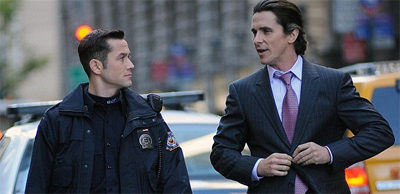








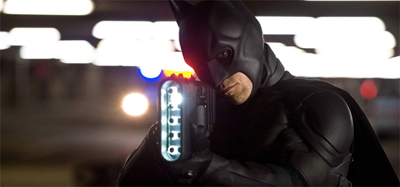

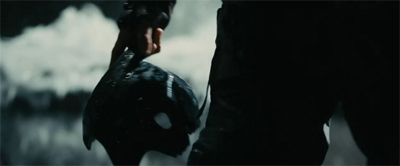
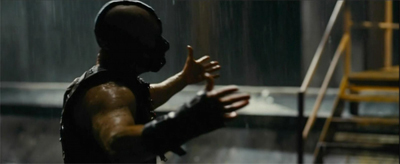



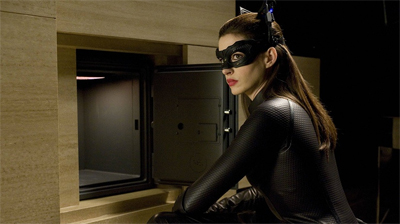



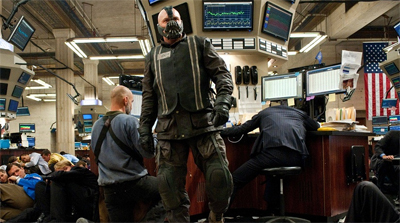


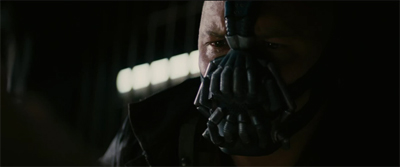


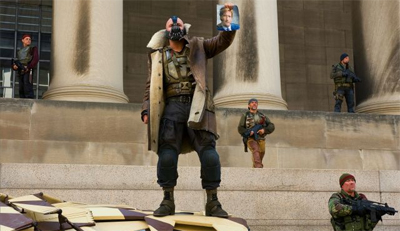



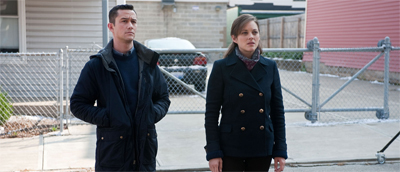
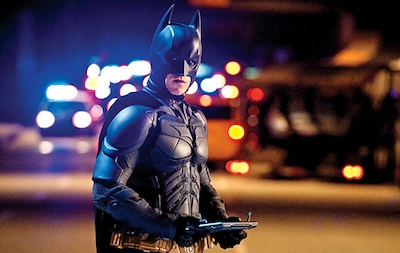
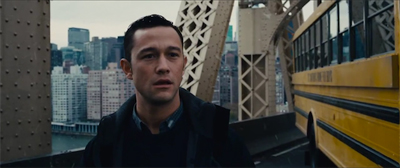




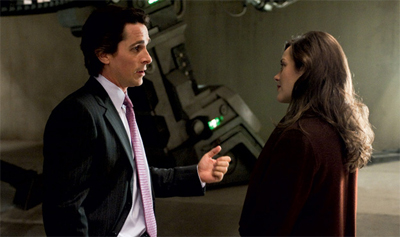
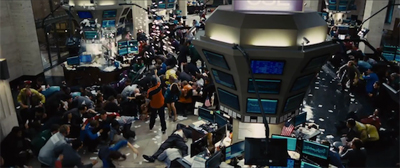
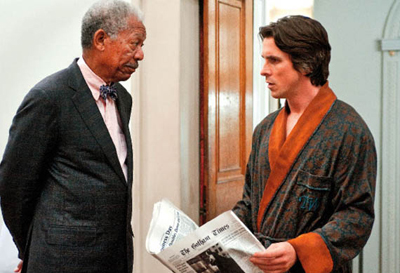
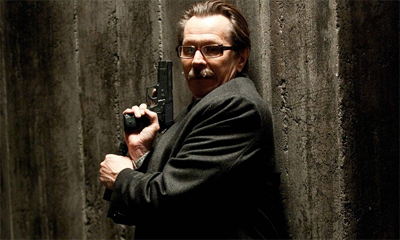

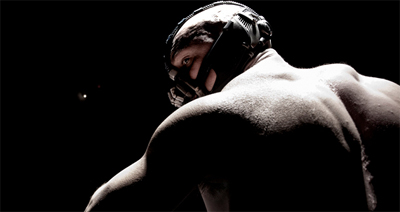





This is the most comprehensive review for this film that I have read. I love the fact that you discuss the themes developed by the movie, not just the plot. Nolan’s films, and especially “The Dark Knight Rises” is about ideas, and your analysis of them is spot on. Thanks.
Thanks Jamie! I think that Nolan’s films are often stunningly put together pieces of cinema, just in terms of mechanics like structure and foreshadowing, complemented with fascinating ideas. I think that The Dark Knight Rises is a bit odd because it leans a little more towards the ideas than the mechanics – but it’s possible I just missed some stuff on my first viewing. I suspect that’s why critical response has been so strange towards it. I think it’s considerably looser than The Dark Knight, Inception, Batman Begins, or The Prestige, but it also has some broader ideas than at least The Dark Knight, Inception and Begins. (The Prestige is my favourite Nolan film, controversially.)
I agree that I wanted the film to be longer. There was enough material for another film about Gotham under siege and Bruce’s return, which I’d have liked as No Man’s Land was the major Batman story when I got into comics (alas, there aren’t enough villains in the Nolanverse. Were Ledger still alive, I’d imagine Joker would have taken Scarecrow’s place decreeing death by exile. Still, it’d been cool if some of the rioters wore Joker war paint.)
Your note that the film was the most fantastical of the trilogy was intriguing. Things like that and TDK’s intentionally over-the-top Two-Face design indicate fans take the notion of realism more seriously than Nolan himself. Some even considered a cat burglar unrealistic, and why Hathaway would play Selina Kyle and not Catwoman. It’s worth noting Bond, a character Nolan is also fond of, treads this line between realism and fantasy, (and I’ll shoehorn here how Bane is a classy brute in the vein of Oddjob, Jaws or Renard.)
Also, Blake had foster parents so his original surname may well be Grayson. Robin Grayson, it’s close enough to Richard ‘Dick’ Grayson I suppose. No one can convince me otherwise, same with Juno Temple’s character, who is credited as Jen but is Holly Robinson to me.
Yep, I never understood how fans argue Nolan is “realistic.” His world is fantastical, it’s just grounded – more liek Game of Thrones than Lord of the Rings if you catch my drift. Game of Thrones is less obviously magical, but it still has bloody dragons in it.
Just regarding the Joker, I imagine he probably would have played a different role than the Scarecrow. Nolan structured the film to pay homage to every villain save the Joker, and the Scarecrow returned as a corrupt authority figure. Personally, and this is pure speculation, I imagine we would have seen the Joker playing some sort of sociological game within Bane’s game – probably playing off the idea that Bane boasted an ordinary person in Gotham holds the trigger. After all, the Joker’s whole thing is that people become animals if you remove the constraints of civilisation, and I felt weird that we didn’t get too much of Gotham descending into anarchy. (Save the montage of the wealthy being attacked, the trials of the rich or the line about cops being hunted “like dogs.” Which is quite a bit, but I expected a tiny bit more – as you said, you know it’s a good thing when a three-hour film leaves you wanting more.)
That said, it’s highly likely the entire film would have looked very different if Heath Ledger had lived. I remember hearing some speculation that the original plan was for the film to revolve around his trial or something, though I can’t remember where I heard that.
I can understand your issues with Bruce and Selina hooking up – and I agree she did some seriously villainous things that if she was played by a less charismatic and appealing actress we as the audience would find it hard to forgive.
Yet… I really could get why Bruce and Selina could recognise the broken parts within each other in a way no ordinary girl or guy respectively would ever be able to. I admit I’m biased because I’m a Batman/Catwoman shipper from the comics and Batman Returns but I’m rooting for those crazy kids to make it.
I have to say… and I feel like I’m being controversial here… while I loved Hathaway as Selina, I though Michelle Pfeiffer was better. The character was totally messed up – what was with the origin? She’s like a cat-resurrected-person? (In fact, the entire film is glorious, enjoyable, grotesquely camp and strangely brilliant mess.) But I think Pfeiffer nailed it, and she brought out the best in Keaton.
Although I’m admittedly biased. Pfeiffer may have been one of my first movie star crushes.
Darren, you jerk! This exhaustive review makes me want to give the movie another chance, even after my wife and I agreed that it was good but not good enough to warrant sitting in the theater for again. Now I have to see it another time!
I linked the non-spoiler review in my blog, but I can’t link this one in good faith, even though it’s far superior. This is by far the best review for TDKR on the Internet I’ve read, good or bad, with only your non-spoiler review coming in at second. Kudos
I’m sorry! If it makes you feel better, I too shall be returning to the film shortly.
And I understand. The review is well and truly spoiler-iffic.
I liked your review. I’m not sure “looser” is the best word to describe TDKR. It seemed to me like a tighter and less clunky story than TDK. While in The Dark Knight everything worked on paper, the transition to China and the transition to the Two Face standoff always felt slightly awkward. I just felt like TDKR moved along like a well-oiled machine.
As for catwoman, it’s hard to compare the two because they aren’t even really the same character. If you want a crazy cat-inspired, “sexy” lunatic, Pfeiffer delivers. If you want a street-smart cat burglar, Hathaway delivers as well. Since I find watching Batman Returns a pretty unpleasant experience, I’d say I prefer Hathaway.
Nah, I think it’s safe to say that Returns is an acquired taste. At the best of times. Still, I love it.
I don’t know. I think that The Dark Knight had a very logical and linear A-to-B-to-C flow. The Dark Knight Rises sort of balloons out in the second act and I don’t think the subplots (Batman in the Pit, the outside reaction to Gotham, Bane’s control of Gotham and the secret police work in Gotham) all gel. They work fine mechanically, and you can see the connection, but I think that there isn’t the same flow. Even in The Dark Knight, the Two-Face climax came after the Joker confrontation. In The Dark Knight Rises, it would have been almost simultaneous, I think. (Gordon would have been doing it, or starting it, while Batman was storming the Trump building or something like that, if it makes sense. As opposed to the more linear, “first Joker, then Dent” flow.)
Wow, what a whopping review! The scope makes sense, though, when you consider the size of the film in question.
I’m going to back you on the “loose” issue. If this film had only been consolidated into tighter movements, we’d be talking masterpiece material. I must also agree that, while Hathaway was brilliant, none can top the “Returns” performance of Michelle P.
I dig what you’re saying about the change in character concerning Gordon but I can’t say that I buy this Gordon missing all the clues, even if he’s disinterested in the answer. Burton’s Gordon, sure.
Glad to see someone agrees with me on Pfeiffer!
I don’t know. I would have loved if Gordon had, at the end, confessed that he knew. That he always knew. (Or at least since the “trying to catch a light” bit in The Dark Knight.) It just didn’t make a difference to him. Still, it’s not a bad way of looking at the character, I think. And it insulates him from the “family friends”, allowing Gordon to be a better objective judge of Batman’s character, I think.
What an excellent review! You’ve really taken your time to review the movie. My thoughts – useless Batman, without too many stunts, cute catwoman who did more action than Batman, Alfred goes away, Robin not there, Bane wasn’t as menacing as the Penguin or Joker, neither does he leave an impression.
Why was Riddler completely forgotten.
Honestly, a long movie which by the end still feels like something was not there.
I think Bane was perfect, to be honest.
And the absence of Batman is a thing people return to – but Batman is always there. That’s why the citizens etch the Bat markings on walls and lamp posts – to illustrate that although the man might be gone, the idea remains. I think there’s much more Batman here than, for example, in Batman Begins, and the length of screentime Bruce is in suit has relatively little impact on the quality of the film.
But each’s own.
(I love the Riddler, but I think he would have been too similar to the Joker. Bane was very much a different sort of challenge, and one who I think countered Batman in a slightly different and yet intriguing way. The Joker threatened Batman morally and philosophically. Bane challenges him physically and mentally.)
Of course something was not there: Heath Ledger. TDKR is a memorial to him, an acknowledgement of the Void, of the meaning of Death in life which is usually masked, dispensed with, shied away from, feared.
I just saw it today so I permitted myself to read this version and it is marvelous. I have never gone to the IMAX because I intended to see only a film there that demanded an enhanced spectacle. After reading your first review I decided that TDKR absolutely required IMAX viewing. The theatre was crowded when I arrived and I had to sit very close to the screen. It was an overwhelming experience. Do it.
I haven’t seen a film in Imax in years. Ireland used to have a screen, but it closed down. Which is a shame, because I am seriously considering flying to manchester to see this in proper Imax.
If you can afford to fly to see a movie then do it. Sit close to be right in it.
To Bane, hope is only useful as a tool to understand despair. Without hope, despair cannot truly exist.
Yes. Nolan has carefully digested post modern thinking and turned it into film art. The fact that the truth becomes a weapon when lies prevail. This is Zizek: Living in the End Times and his very recent book of 1000+ pages on Hegel: Less Than Nothing. It is clear to me what Nolan has been reading and feeding himself with. What a relief. Babette Babich reminds us that opposites always include each other, that they are not separate, just inversions and you have emphasized this in many many ways in this review.
We must change the way we think, speak and write about our world. You have.
Thanks you very much.
Wayne; wane. Bruce Wayne is waning.
I’d almost have been happy to leave it with the passionate kiss and have Bruce at that French café alone. It just seems a little bit weird, but then I think that short clip was too long – as mentioned above, I’d have rathered Nolan kept Bruce’s fate a tiny bit more ambiguous.
But the ending is very ambiguous. We discussed that going to the car. My friend said the ending came from House which I have never seen any of.
My perception: Much earlier Alfred tells Bruce he might have seen him at a cafe in Florence and was happy. In that quick scene Alfred is looking at the back of whom he thinks is Wayne and smiles. His gaze is then diverted and we see the man turn around and it isn’t Wayne at all.
At the end He “sees” Wayne and Selina. Does he see them? Is he hallucinating them? that’s a bit strong I think, perhaps he is imagining them? Or is it really them? His first confusion earlier led me to think his ambiguous perception there became wishful thinking? Imagination? For me it was ambiguous.
All your deconstruction of “masks” leads to a Lacanian reading of TDKR and this is far richer than a classic Freudian or psychological one. Bane, Wayne, pain, pane, window, seeing through, transparent. Nolan is taking masses of people, young adults and children into the paradoxes of linguistics. HOORAY!
Great work darren.
I love that idea of paradoxical linguistics. As I noted in your review, it never even occurred to me how even the name Bane evokes Wayne. (Or, rather, bain and wain (“on the…”).)
I like the faint hint of ambiguity, but I do think the shot is perhaps a little too long. I love the idea of hope existing, but without a definite answer. After all, it’s not hope if Gordon, Alfred and Lucius can be 100% certain he survived.
Finally saw TDKR and have now read many many reviews and comments. Yours is by far the most comprehensive. its clear and honest and extremely insightful. makes me want to see the movie(and the trilogy) again.
Waht I disliked in most reviews is that people mostly want to judge it as a standalone or compare it to TDK. It is the end of a trilogy and having rewatched the first 2 parts before seeing TDKR all the connections you made above are very clear and make the movie so much more enjoyable.
I laso read a lot about themes that were touched upon but not fleshed out. (occupy movement , class differences etc.) I can see that but I do not think that were the themes that really count, but more the themes you write about and they were certainly fleshed out as you so brilliantly describe.
I personally had some troubles with Bane. Mostly due to his voice(sounded like a Connery/Neeson accent that came from the IMAX speakers instead of him) and the acting with a mask is pretty tough task. Hoping I can enjoy him more on a second viewing.
Gotham under siege was a bit thin. And the knowing that Tate was Thalia took away the plot reveal. The movieflow in general was a of a bumpy highspeed ride.
But still i came out of the theater thinking/feeling this one was maybe even better than TDK. But without the Joker that is basically impossible.
Loved the movie, loved the trilogy and loved your review.
Many Thanks!
Thanks, crackd!
I think there’s a valid argument to be made that TDKR is as good as TDK would have been without Heath Ledger. Although, as my better half countered, that’s impossible to really quanitify.
I loved Bane, and I never found him too difficult to understand. I think Hardy does a phenomenal job, given you can’t see his mouth. Something I picked up on my thrid viewing was while he was reading Gordon’s “confession” to the people, Hardy has Bane wonderfully shake his head as if in mock indignation. It’s very clear that – much like the Joker – Bane is loving every moment of this.
I keep saying that the absence of The Joker made him more present than ever.
You’ve easily given the best review of the film I’ve seen, but you didn’t go too in depth on Selina Kyle’s role in the film. Opinions?
I really liked Anne Hathaway’s Selina Kyle. Probably Christopher Nolan’s strongest female character to this point – one that actually feels like a real character with her own clear character and narrative arc. It is really great, and Hathaway is superb.
And I say that as a big fan of Michelle Pfeifer’s performance in Batman Returns. I could have done without the weird inexplicable magic cat stuff there, but I liked the idea of Catwoman as a feminist character in what was (to that point) largely a boy’s club (in terms of on-screen superheroics).
I’m with public opinion in thinking that The Dark Knight is one of the greatest films ever, and I also love Batman Begins, but for whatever reason, I find this movie incredibly boring. Maybe because the villains have no motivation, maybe because it comes off like no one cares half the time, I don’t know, it just is, I almost fell asleep before it was finished, and I haven’t seen it since, unlike The Dark Knight, which had me glued for two and a half hours and I’ve seen a million times.
Yeah, revealing Talia to be the true villain in the end was quite a shock for me. One of the advantages of not being privy to Batman lore.
Nice to hear how that worked for somebody not familiar with the character’s mythology.
Yes TDKR is a great movie. A great classic.